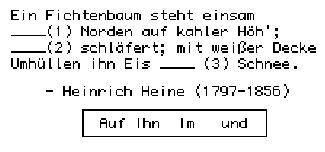| (1) df | _13_ |
||
| (2) F | ___ |
||
| (3) Ho | ___ |
||
| (4) k | ___ |
||
| (5) N | ___ |
||
| (6) n | ___ |
||
| (7) ρ | ___ |
||
| (8) r | ___ |
||
| (9) r2 | ___ |
||
| (10) r2 | ___ |
||
| (11) ζ, SD, Sx | ___ |
||
| (12) s2 | ___ |
||
| (13) χ2, c2 | ___ |
||
| (14) |
___ |
||
| (15) v | ___ |
||
| ___ |
|||
| Part 1: Terminology |
Part 2: Procedures |
Part 3: Test Interpretation |
Part 4: Assessment Ethics |
INSTUCTIONS: Below is a list of possible items for three different foreign language assessment literacy tests: one for professional test validators (Level A), one for language teachers with bachelor degrees in education (Level B), and yet another for first year undergraduate education majors (Level C). If you think that an item represents something that professional language test validators should know, mark "Level A". If you believe that an item should be known by foreign language teachers with B.A. degrees, mark "Level B". If you think that an item is something an education major should know before entering college, mark "Level C". If you believe it's not necessary for any of these three populations to know a given item, leave it blank. Please remember that Levels A, B, and C represent - in your view - the minimal competency levels for each of these three populations. If an item is beyond what you believe a member of a group ought to know, then leave it blank.
It's not necessary to answer any of the items below, but you're welcome to do so if you wish. When clicking the boxes for Levels A, B, and C remember that you may click more than one box if it seems appropriate or leave all boxes blank.
When you have completed this document, please email a copy to timothy*at*toyonet*dot*toyo*dot*ac*dot*jp. Thank you for your cooperation.
| (1) df | _13_ |
||
| (2) F | ___ |
||
| (3) Ho | ___ |
||
| (4) k | ___ |
||
| (5) N | ___ |
||
| (6) n | ___ |
||
| (7) ρ | ___ |
||
| (8) r | ___ |
||
| (9) r2 | ___ |
||
| (10) r2 | ___ |
||
| (11) ζ, SD, Sx | ___ |
||
| (12) s2 | ___ |
||
| (13) χ2, c2 | ___ |
||
| (14) |
___ |
||
| (15) v | ___ |
||
| ___ |
|||
[ p. 62 ]
(B) Multiple choice questionsNote that some items have more than one "correct" possible response. |
| 16. Gender, occupation, or nationality are considered
|
|
17. If a test only seems to measure what it claims to, then it is said to have |
|
18. A error occurs when a researcher thinks there is no |
|
19. The cutoff point for a criteria-reference test should be |
|
20. Exams used to determine a student's progress toward mastery of a |
|
21. How many standard deviations a score is from the mean is revealed |
22. The test excerpt below is an example of a test. 
|
23. To find out how well a particular item in a test correlates with the total |
|
24. Any variable that is not part of a research study, but still has an effect on its results |
|
25. In a 3-parameter IRT test model, the point on an ability scale at which the probability of a |
|
26. To predict how many more items need to be added to a given test to increase its reliability |
|
27. If a test is uni-dimensional, then it should automatically show a high degree of |
|
28. The tendency of examinee expectations to contaminate test results is known as |
|
29. A test administration procedure in which a large set of test items is organized into |
30. To compare a the mean of a particular sub-group to the mean of a larger group |
|
31. Briefly explain the difference between the standard error of estimate (SEE) |
|
32. If you want to see how closely "masters" who scored high on a particular CRT test differed |
|
33. What's the difference between a predictive and concurrent validation study? |
|
34. How do the Kuder-Richardson Formula 20 and Formula 21 differ? |
|
35. What does the central limit theorem tell us? |
| Main Article | Appendix A: I II III IV | Appendix B | Appendix C: I II III IV |